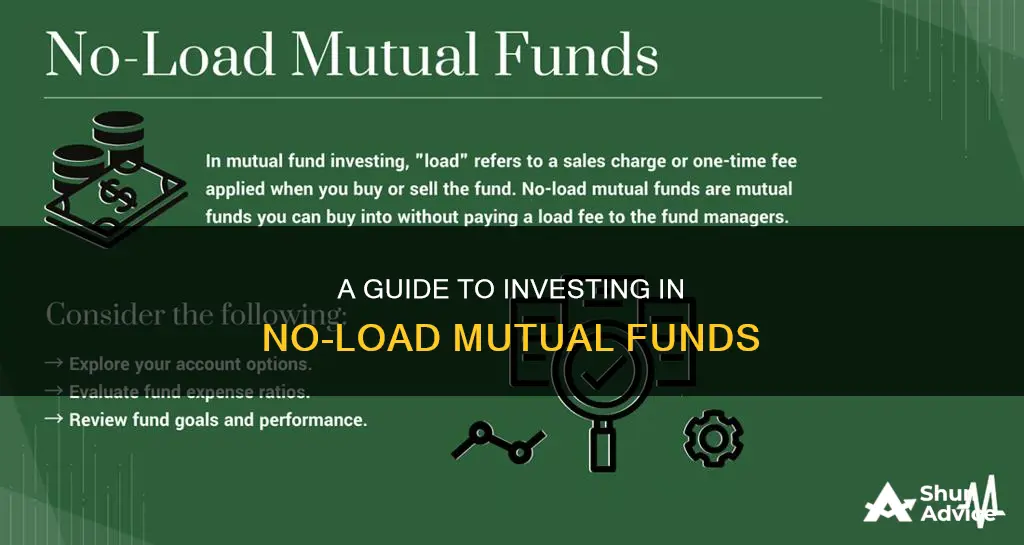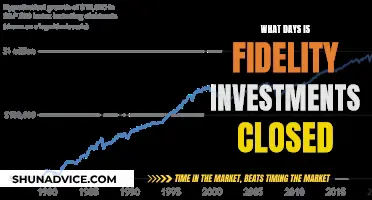
No-load mutual funds are an attractive option for investors looking to limit the fees they pay by cutting out the middlemen, such as investment advisers and brokers. These funds are purchased either directly from the company or through a brokerage firm, and they do not have sales charges attached to them. However, it's important to note that even no-load funds may have expense ratios, which represent the cost of running the fund.
When considering investing in mutual funds, it's essential to be aware of the various fees that may be incurred. Load funds, for example, charge a sales fee or commission, which could be a percentage of the investment amount or a flat fee. This load fee is paid to compensate intermediaries such as brokers or financial advisors for their services.
By choosing a no-load fund, investors can avoid these sales charges, allowing more of their money to be invested and potentially increasing their returns over time. However, it's crucial to remember that no-load funds may still have other fees, such as management or redemption fees, so conducting thorough research before investing is always recommended.
| Characteristics | Values |
|---|---|
| Fees | No or low fees |
| Sales charges | No sales charges |
| Commission | No commission |
| Sales intermediary | No intermediary |
| Fund purchase | Direct from company or through brokerage firm |
| Performance | May outperform load funds |
| Control | More control over investment |
| Redemption fee | Charged for early redemption |
| Recommendation | Less likely to be recommended by financial advisers |
What You'll Learn

Understand the difference between load and no-load funds
When it comes to investing in mutual funds, fees are an important consideration. All mutual funds charge fees, but some are more expensive than others due to load fees. Load fees are sales charges or commissions paid to intermediaries like brokers, financial planners, or investment advisors. These fees can be subtracted from the amount invested, reducing the potential return over time.
Load fees can be charged at the time of purchase (front-end load), at the time of sale (back-end load), or as a yearly charge for as long as the investor holds a stake (level load). The fee could be a percentage of the amount invested or a flat fee. For example, a 5% front-end load on a $1,000 investment would result in a fee of $50, leaving only $950 to be invested.
No-load funds, on the other hand, do not charge a commission or sales fee for buying or selling the fund. This means that more of the investor's capital is invested, rather than going towards fees. No-load funds are possible because the shares are distributed directly by the investment company, instead of through a secondary party. Over 90% of mutual funds are no-load funds.
While no-load funds have the advantage of lower fees, there are instances where load funds may be preferred. Some investors feel more comfortable making investment decisions with the guidance of a financial advisor or broker, who can provide expertise in selecting the appropriate mutual fund. Additionally, load funds may be suitable for those who do not have the time or expertise to conduct their own research and make investment decisions independently.
Investing in Commodity Funds: Why Do People Do It?
You may want to see also

Research and compare fees
When researching and comparing fees for no-load mutual funds, it's important to understand the different types of fees and charges that may be involved. While no-load funds don't charge a commission or sales fee when buying or selling shares, there may still be other costs associated with investing in these funds. Here are some key points to consider:
Types of Fees
- Expense ratios: No-load mutual funds may still have expense ratios, which represent the cost of running the fund, including management fees. It's important to look for funds with low expense ratios, as this can minimize fees and maximize returns. The expense ratio is typically expressed as a percentage of the total amount invested and can be found in the fund's prospectus or online information provided by the sponsor.
- 12b-1 fees: Some no-load funds may charge a 12b-1 fee, which is associated with the cost of marketing or distribution for the fund. According to the Financial Industry Regulatory Authority (FINRA), these fees are capped at 0.75% and should not exceed 0.25% for shareholder services.
- Redemption fees: These fees are charged when an investor sells their shares within a specified period, often before a certain number of years have passed. No-load funds may charge a redemption fee for early withdrawals.
- Management fees: These fees compensate the fund managers, traders, and analysts for their work in selecting and managing the fund's investments. While these fees are necessary, they can eat into your returns, so it's important to consider them when comparing funds.
- Account fees: Account fees are typically deducted annually from the investor's account and are usually calculated as a percentage of the account value.
- Exchange fees: These fees are charged when an investor swaps money between different funds within the same company.
Comparing Fees
When comparing fees for no-load mutual funds, it's recommended to use resources such as FundAnalyzer.com, a searchable database of fund fees maintained by FINRA. This tool allows investors to compare all fees charged for a mutual fund, including load fees, management fees, and redemption fees. Additionally, investors can always refer to the fund's prospectus, which discloses all fees and the fund's expense ratio.
It's important to remember that even though no-load funds don't charge sales commissions, they may still have various fees that can impact your returns. Therefore, due diligence is crucial when selecting a no-load mutual fund. Compare multiple funds, analyze their fee structures, and consider their past performance to make an informed decision.
Mutual Fund Investment: Quick, Easy, and Accessible
You may want to see also

Learn about expense ratios
No-load mutual funds are funds that allow investors to limit the fees they pay by cutting out the middlemen, notably investment advisors and brokers. While no-load funds don't have sales charges attached to them, they may still have expense ratios.
An expense ratio is the cost of owning a mutual fund or ETF. It is the management fee paid to the fund company for the benefit of owning the fund. The expense ratio is measured as a percentage of your investment in the fund. For example, a fund may charge 0.30 percent, meaning you'll pay $30 per year for every $10,000 you have invested in that fund.
Expense ratios are important to understand because a high expense ratio can significantly impact your returns. It pays for things like the management of the fund, marketing, advertising, and any other costs associated with running the fund. When someone discusses how expensive a fund is, they're usually referring to the expense ratio.
The expense ratio of a fund is calculated as follows:
Expense ratio (percentage) = Total fees charged annually/your total investment
When looking to invest in no-load mutual funds, it's important to consider the fund's expense ratio and whether it falls below the asset-weighted average. As far as costs go, the lower, the better.
Seeking Investment Funds for Your Dream Zoo
You may want to see also

Know the restrictions on no-load funds
No-load funds are often sold directly by the investment company, rather than through a third-party sales firm. However, some companies, such as banks or broker-dealers, may charge their own fees for handling the transactions.
There may be limitations on the redemption of no-load shares. Shares in a no-load fund can be sold or redeemed only after a specific period. There will be a fee for early redemptions. If you are a long-term investor, this won't be a concern.
No-load funds are best suited to those who are comfortable making their own investment decisions and don't require the services of a financial adviser.
Best Vanguard Funds for Your Roth IRA
You may want to see also

Identify reputable no-load funds
No-load funds are mutual funds that do not charge a commission or sales fee when buying or selling shares. Over 90% of mutual funds are no-load funds, and they are often sold directly by the investment company.
When researching no-load funds, it's important to remember that they can still charge other fees, such as redemption or annual management fees. Checking the fund's prospectus or online information provided by the sponsor will give you the fund's expense ratio, which is the annual cost of owning a mutual fund, expressed as a percentage of the total amount invested.
- Check the fund's performance history: Look at the fund's past performance over different periods, such as one, three, five, and ten years. Compare it with similar funds and the market index to see how it has performed relatively.
- Research the fund's strategy: Understand the fund's investment objectives, strategies, and the types of assets it invests in. Make sure they align with your investment goals and risk tolerance.
- Evaluate the fund's management: Review the reputation and track record of the fund's management team. Look for experienced fund managers with a successful history of generating returns.
- Consider the fund's expenses: While no-load funds don't charge sales fees, they may have other expenses, such as management fees or 12b-1 fees. Compare these expenses with similar funds to ensure they are competitive and won't eat into your returns too much.
- Look for recommendations and ratings: Reputable financial websites and magazines often provide ratings and recommendations for mutual funds. Look for funds that have consistently received high ratings from multiple sources.
- Assess the fund's risk level: Understand the level of risk associated with the fund's investments. Consider your own risk tolerance and whether the fund matches your comfort level.
- Review the fund's prospectus: The prospectus contains important information about the fund, including its investment objectives, fees, and risks. Make sure you carefully review this document to understand all the details of the fund.
By following these steps and conducting thorough research, you can identify reputable no-load funds that align with your investment goals and help you build your investment portfolio.
Strategies to Attract Investors to Your Fund
You may want to see also
Frequently asked questions
No-load mutual funds are funds that do not charge a commission or sales fee when buying or selling shares. In other words, you don't have to pay a fee to put money in the fund or take it back out.
No-load funds offer cost savings to investors. When you buy shares of a mutual fund that charges a load fee, it comes with an extra charge just for the act of investing. This fee can eat into your returns over time. With no-load funds, you avoid these fees, meaning more of your money is working for you in the market.
You can purchase no-load funds directly from the company or through a brokerage firm. However, some companies, such as banks or broker-dealers, may charge their own fees for handling the transactions.
Some examples of no-load mutual funds include the Vanguard 500 Index Fund, the Fidelity 500 Index Fund, and the Vanguard International Core Stock Fund.







